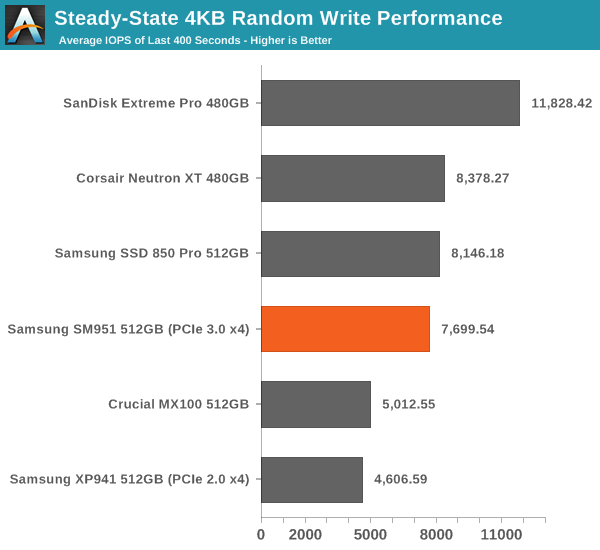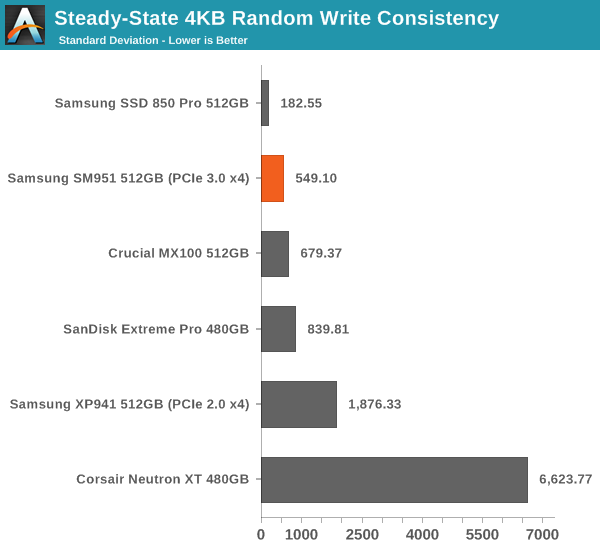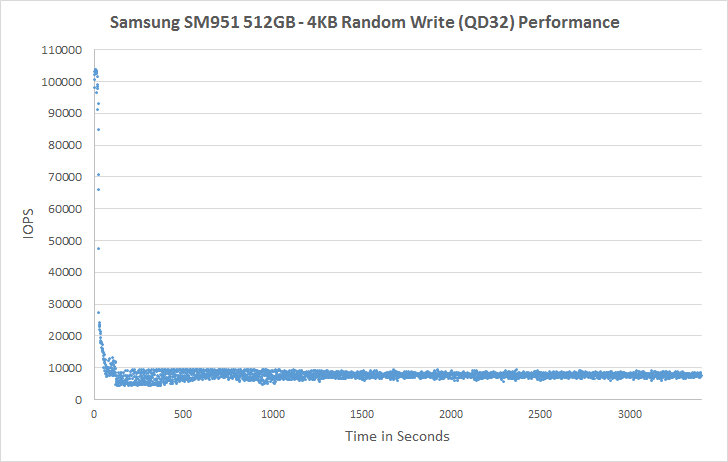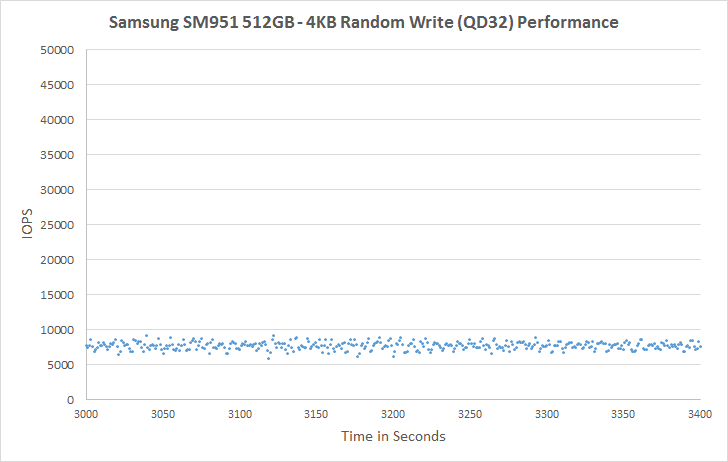Samsung SM951 (512GB) PCIe SSD Review
by Kristian Vättö on February 24, 2015 8:00 AM ESTPerformance Consistency
We've been looking at performance consistency since the Intel SSD DC S3700 review in late 2012 and it has become one of the cornerstones of our SSD reviews. Back in the days many SSD vendors were only focusing on high peak performance, which unfortunately came at the cost of sustained performance. In other words, the drives would push high IOPS in certain synthetic scenarios to provide nice marketing numbers, but as soon as you pushed the drive for more than a few minutes you could easily run into hiccups caused by poor performance consistency.
Once we started exploring IO consistency, nearly all SSD manufacturers made a move to improve consistency and for the 2015 suite, I haven't made any significant changes to the methodology we use to test IO consistency. The biggest change is the move from VDBench to Iometer 1.1.0 as the benchmarking software and I've also extended the test from 2000 seconds to a full hour to ensure that all drives hit steady-state during the test.
For better readability, I now provide bar graphs with the first one being an average IOPS of the last 400 seconds and the second graph displaying the standard deviation during the same period. Average IOPS provides a quick look into overall performance, but it can easily hide bad consistency, so looking at standard deviation is necessary for a complete look into consistency.
I'm still providing the same scatter graphs too, of course. However, I decided to dump the logarithmic graphs and go linear-only since logarithmic graphs aren't as accurate and can be hard to interpret for those who aren't familiar with them. I provide two graphs: one that includes the whole duration of the test and another that focuses on the last 400 seconds of the test to get a better scope into steady-state performance.

In steady-state performance the SM951 provides a substantial ~70% upgrade over the XP941 and brings performance nearly to the same level with the 850 Pro. Given that the 850 Pro uses faster V-NAND, the steady-state performance is a pleasant surprise and shows that the SM951 is more than a marginal bump from the XP941. Obviously, drives with more default over-provisioning (i.e. Extreme Pro and Neutron XT) provide higher steady-state performance, but Samsung is doing very well with the default 7% over-provisioning.

The consistency of the SM951 is also great. The Neutron XT is a living proof of a drive with high average IOPS, but horrible consistency because as we can see in the graph above its standard deviation is up to dozens of times higher compared to the other drives. That's just not acceptable for a modern drive, especially because there are many drives that can consistently provide high IOPS.
 |
|||||||||
| Default | |||||||||
| 25% Over-Provisioning | |||||||||
For a dozen seconds or so, the SM951 is actually able to burst out 100K IOPS, but the performance soon drops to below 10K IOPS and eventually evens out at ~7.5K IOPS. The SM951 is very consistent and doesn't experience any notable IOPS drops, whereas the XP941 regularly drops to a few hundred IOs per second. Increasing the over-provisioning to 25% brings the IOPS to about 35K, which is very decent and again much better than the XP941 that still has odd drops in performance.
 |
|||||||||
| Default | |||||||||
| 25% Over-Provisioning | |||||||||










128 Comments
View All Comments
Kristian Vättö - Tuesday, February 24, 2015 - link
PCIe adapters are fine for review purposes and are in fact more easily serviceable than M.2 slots tend to be.Samus - Tuesday, February 24, 2015 - link
Thank you for pointing out all capacities are M2 2280 DOUBLE SIDED. That is missing from virtually all reviews, sales material and eCommerce sites for M2 drives. Newegg has been pretty good about taking pictures of both sides of many drives, though.This is important to me because I work with HP Elitebook's and the newest generation of the Elitebook 810 (G2) and 820\1040 all require single-sided. The 840 has room for M2 DS modules, though.
Flash13 - Tuesday, February 24, 2015 - link
The company is not trustworthy! Buy at your own risk. Good Luck.youtard - Tuesday, February 24, 2015 - link
hurr!Wardrop - Tuesday, February 24, 2015 - link
Does this form factor work in standard desktop PCI-e 4x slots?DanNeely - Tuesday, February 24, 2015 - link
It's an m-2 plug, you need an adapter to fit it in a standard pcie slot.wtallis - Wednesday, February 25, 2015 - link
When discussing NVMe, please make it clear that the chipset and motherboard firmware only matter for booting off the drive; they don't need any updates to allow a compatible operating system to access the drive as something other than the boot volume.(As for what the motherboard firmware needs to gain in order to allow booting from NVMe devices, it's just a loadable UEFI device driver. Even if your motherboard doesn't have such a driver built-in, you could load it from some other storage device and then boot off the NVMe drive.)
ericgl21 - Wednesday, February 25, 2015 - link
I wonder if Samsung (or any other OEM) would be willing to sell a 1TB m.2 NVMe PCIe3.0 x4 SSD with SLC NAND with a 2280 form factor?Many professionals would appreciate the speed and reliability that SLC NAND provides.
Sure, it would cost a lot, but so do the Samsung SM951 and Intel P3700.
If that's not possible with current 16nm manufacturing, then a 512GB would also be nice. :-)
Just my 2 cents.
baii9 - Wednesday, February 25, 2015 - link
reliable on nand? Reliable controller matters, high endurance nand matters, I think nand are "reliable' enough already(compare to that lovely controller).IlikeSSD - Wednesday, February 25, 2015 - link
looks like Samsung paid for not showing OCZ in consistency and mixed workload tests )))))